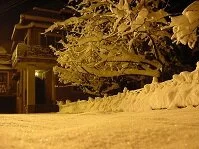Weather

Winter snows
Moldova's seasons are fairly distinct as the country receives a mild continental climate. Winters (December-February) can be very cold and rarely get above freezing in some parts of the country, but also tends to be dry so gets little snow. Average temperatures throughout the country during the winter months is about 25˚ F (-4˚ C), although the land closest to the Black Sea is generally a bit warmer, while the north tends to be a bit cooler.
In the spring and fall (autumn), temperatures and precipitation can be inconsistent. Temperatures can range as widely as freezing to 70˚ F (21˚ C) within a single month and again the lands closest to the Black Sea tend to remain a bit more consistent, rarely having the extreme swings.
Summers in Moldova have averages of about 70˚ F (21˚ C), with daily highs typically reaching 80˚ F (27˚ C) in most of the country, although the southern lands near the Black Sea generally don't get as hot. These long summers receive a fair amount of rainfall, which allows great crop growth. The rains are fairly evenly distributed throughout the spring and summer, although in any year dry spells can and have occurred, hurting the farm production. During springs and summers with greater rainfall, the lowlands and the river valleys can get flooded. The north generally receives a little more rain than the south and the far southwest is the driest part of the country.
These seasonal variations and consistent rainfall, like the landscape, provide an ideal environment for life to thrive as water is easily accessible and this water also allows for the growth of various foods.
Learn More about Moldova's Weather:
-The Moldovans: Romania, Russia, and the Politics of Culture by Charles King. Hoover Institution Press. Stanford, CA U.S.A. 2000. (Buy Now)
-www.weather.com
Wildlife
Just as the living conditions are ideal for human life and plants, they are also excellent for animal life and there is a decent variety of animals in Moldova, beginning with mammals. For much of history the country has been home to larger mammals like deer, boars, brown bears, and grey wolves, but few of these animals are present in large numbers today. Smaller mammals are much more common as badgers, beavers, squirrels, rabbits, otters, mink, and weasels are all common as are numerous rodents. Again, many of these smaller mammals are shrinking in numbers; much of the country was at one time forested and these small mammals found homes there, but as the trees were cleared for farm land in the 1800s many of these animal populations have decreased drastically.
The people have also introduced and bred some mammals to increase their numbers, including cattle and sheep. Today these mammals contribute to a substantial part of the Moldovan diet for both meat and dairy products. Pigs are also breed regularly today for their meat.
There are a number of rivers running through the landlocked country, but few large lakes and no direct access to a saltwater sea or ocean. Due to this environment, the sea life in Moldova is somewhat limited in scope; however these rivers and lakes are home to a number of freshwater fish. Perhaps the two most common fish in the rivers of Moldova are perch and pike. Although these fish are limited in numbers and in accessibility, the people near the rivers and lakes often fish and make these animals a part of their diet.
Located near the Black Sea, Moldova receives many migrating birds and, as a fertile land, encourages stop-overs or stays by many of these bird species. These birds include a large number of waterfowls and woodland birds. There are also a number of birds that are now bred as a food source, most notably chickens, who are also used for their egg production, but are not native to Moldova, although they arrived thousands of years ago.
The reptilian and amphibian life in Moldova is fairly limited compared to the mammalian or avian species, but both do exist in the country. Moldova is home to a limited number of snakes, frogs, and toads among others.
Learn More about Moldova's Wildlife:
-The Moldovans: Romania, Russia, and the Politics of Culture by Charles King. Hoover Institution Press. Stanford, CA U.S.A. 2000. (Buy Now)